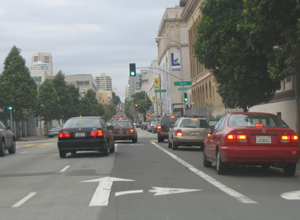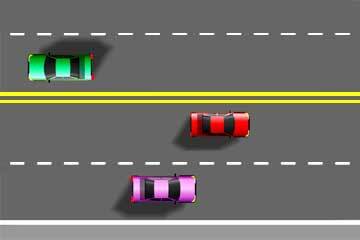Markings: Colors, Patterns, Meaning
Welcome to our quick and easy driving information guide

WHITE LINES painted on the pavement indicate traffic traveling in your direction.
Broken White Line: you may change lanes if it is safe to do so.
Solid White Line: requires you to stay within the lane and also marks the shoulder of the roadway.

YELLOW LINES mark the center of a two-way road used for two-way traffic. You may pass on a two-way road if the yellow centerline is broken. When a solid and a broken yellow line are together, you must not pass if you are driving next to the solid line. Two solid yellow lines mean no passing. Never drive to the left of these lines.

It's okay to cross a double yellow line to turn left. YOU CANNOT cross a double yellow line to pass another vehicle.

Two sets of solid double yellow lines that are two or more feet apart sometimes appear as a road marking. Such lines stand for a solid wall. Don't drive on or over these road markings. You may not make a left turn or U-turn across it.

Turn Lanes
Turn lanes are found in the middle of some two-way streets. The lane is marked on both sides by two painted lines—inner line broken, outer line solid. Use this lane only for making left turns.
Stop Lines

A stop line is a wide white line painted across the street. When a crosswalk or limit line is not marked, stop at the corner. Check for traffic before crossing. Wait until it is safe before going forward.
Edge of Pavement Lines

Edge lines are used to outline and separate the outside edge of the pavement from the shoulder. Right edge lines are marked with a solid white line and left edge lines are marked with a solid yellow line.
© 1997-2025 DriversEd.com. All rights reserved. Please see our privacy policy for more details.






